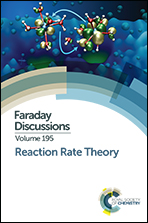Pressure-dependent rate constants for PAH growth: formation of indene and its conversion to naphthalene†
Abstract
Unraveling the mechanisms for growth of polycyclic aromatic hydrocarbons (PAHs) requires accurate temperature- and pressure-dependent rate coefficients for a great variety of feasible pathways. Even the pathways for the formation of the simplest PAHs, indene and naphthalene, are fairly complex. These pathways provide important prototypes for modeling larger PAH growth. In this work we employ the ab initio RRKM theory-based master equation approach to predict the rate constants involved in the formation of indene and its conversion to naphthalene. The reactions eventually leading to indene involve C9Hx (x = 8–11) potential energy surfaces (PESs) and include C6H5 + C3H4 (allene and propyne), C6H6 + C3H3, benzyl + C2H2, C6H5 + C3H6, C6H6 + C3H5 and C6H5 + C3H5. These predictions allow us to make a number of valuable observations on the role of various mechanisms. For instance, we demonstrate that reactions which can significantly contribute to the formation of indene include phenyl + allene and H-assisted isomerization to indene of its major product, 3-phenylpropyne, benzyl + acetylene, and the reactions of the phenyl radical with propene and the allyl radical, both proceeding via the 3-phenylpropene intermediate. 3-Phenylpropene can be activated to a 1-phenylallyl radical, which in turn rapidly decomposes to indene. Next, indene can be converted to benzofulvene or naphthalene under typical combustion conditions, via its activation by H atom abstraction and methyl substitution on the five-membered ring followed by isomerization and decomposition of the resulting 1-methylindenyl radical, C10H9 → C10H8 + H. Alternatively, the same region of the C10H9 PES can be accessed through the reaction of benzyl with propargyl, C7H7 + C3H3 → C10H10 → C10H9 + H, which therefore can also contribute to the formation of benzofulvene or naphthalene. Benzofulvene easily transforms to naphthalene by H-assisted isomerization. An analysis of the effect of pressure on the reaction outcome and relative product yields is given, and modified Arrhenius fits of the rate constants are reported for the majority of the considered reactions. Ultimately, the implementation of such expressions in detailed kinetic models will help quantify the role of these reactions for PAH growth in various environments.
- This article is part of the themed collection: Reaction Rate Theory

 Please wait while we load your content...
Please wait while we load your content...